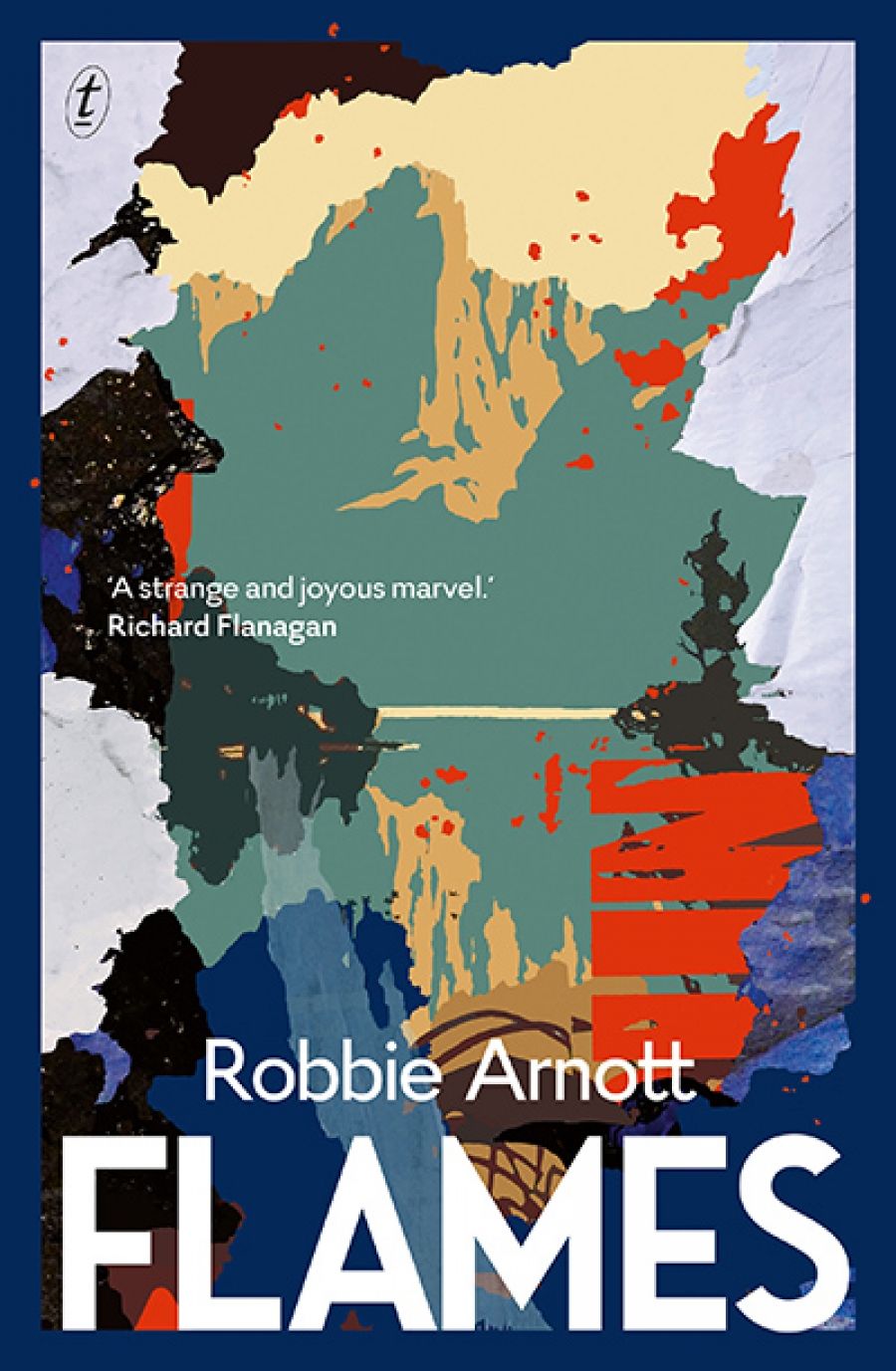
- Free Article: No
- Contents Category: Fiction
- Custom Article Title: Amy Baillieu reviews 'Flames' by Robbie Arnott
- Review Article: Yes
- Online Only: No
- Custom Highlight Text:
Robbie Arnott’s Flames is an exuberantly creative and confident début. Set in an alternate Tasmania, Flames’s kaleidoscopic narrative crackles with energy and imagination. This is a world of briefly reincarnating women, gin-swigging private detectives, wombat farms, malevolent cormorants, elementals and nature gods ...
- Book 1 Title: Flames
- Book 1 Biblio: Text Publishing, $29.99 pb, 226 pp, 9781925603521
Arnott sets the tone from the opening sentences: ‘Our mother returned to us two days after we spread her ashes over Notley Fern gorge. She was definitely our mother – but, at the same time, she was not our mother at all.’ As the reader swiftly discovers, ‘This kind of thing wasn’t uncommon’ in Levi McAllister’s family. After cremation, ‘around one third’ of the McAllister women are ‘re-spawned’ by the landscape where their ashes have been spread to complete ‘unfinished business, old grudges, forgotten chores’. After their mother returns with ‘her skin carpeted by spongy, verdant moss and thin tendrils of common filmy fern … [her hair] replaced by cascading fronds of lawn- coloured maidenhair’, Levi starts to worry about his sister Charlotte and contacts the reclusive author of The Wooden Jacket to provide her with an alternative post-mortem fate. When the grieving but otherwise healthy twenty-three-year-old discovers Levi’s plans for her bespoke coffin, she flees. For ‘all she has left of her mother are photos and memories and a family tradition of flames, and she won’t let him take them from her. Charlotte will burn … And she might return. Though that isn’t the point.’
Fire, regeneration, and transformation are central to this multifaceted novel. Each chapter is narrated from a different perspective and in a variety of styles. Arnott plays assuredly with generic conventions and expectations. ‘Ice’, his take on the hardboiled detective genre, is particularly entertaining. At one point, the unnamed private detective Levi has hired to look for Charlotte laconically lists some of the more unusual people she has encountered: ‘blackmailers who’d stolen souls with high-powered cameras; thieves who’d sold their shadows to puppeteers; adulterers who’d swapped faces with gargoyles. You name it, I’d seen it. And I’d investigated it, solved it, and been home by nine with a glass of gin and a thick sandwich.’
The epistolary chapter ‘Fur’ is less convincing, thanks to one correspondent’s inexplicably vitriolic rages and melodramatic Victorian style: ‘Mr Idiot, You scum. You ill-mothered baboon. You parasitic swineherding subhuman mongoloid’ opens one letter. The reasons behind Thurston Hough’s huffiness are unclear, and his fussy locution breaks the narrative spell.
Other chapters include diary entries that detail a descent into madness and gothic horror on a remote wombat farm; a gossipy extract from a memoir by ‘Avoca matriarch’ Mavis Midcurrent (which, fittingly, appears midway through the book); two chapters written in the present tense in an almost incantatory style; and a moving origin story that encompasses several thousand years of Tasmanian history, including (briefly) the traumas of colonisation. ‘Salt’, ‘Iron’, and ‘Coal’ are affecting in their explorations of love and grief, joy, and rage, and the lingering aftershocks of unexpected events. The impact humanity has had on Tasmania’s natural environment is another recurring motif, and woven through each layer of the novel is the increasingly tense story of the McAllisters.
 Robbie ArnottAlthough the main plot is compelling, Arnott’s descriptions of the Tasmanian landscape and its inhabitants (eldritch and otherwise) are the real highlight of this invigorating, strange, and occasionally brutal novel. The legendary Oneblood tuna is ‘a missile of muscle and scales’, while the sky is a ‘hard blue smear’, and a window shows ‘the peeled tide and oozing mudflats of the river’. A memory is ‘sharp as snapped glass’, and one character wonders at ‘the swishing luminescence of the southern lights, painting the winter nights loud. He saw it all, all that was small and huge and wild and strange.’
Robbie ArnottAlthough the main plot is compelling, Arnott’s descriptions of the Tasmanian landscape and its inhabitants (eldritch and otherwise) are the real highlight of this invigorating, strange, and occasionally brutal novel. The legendary Oneblood tuna is ‘a missile of muscle and scales’, while the sky is a ‘hard blue smear’, and a window shows ‘the peeled tide and oozing mudflats of the river’. A memory is ‘sharp as snapped glass’, and one character wonders at ‘the swishing luminescence of the southern lights, painting the winter nights loud. He saw it all, all that was small and huge and wild and strange.’
Arnott’s dialogue doesn’t have the same spark as his narrative voice, and the originality of his descriptions, particularly those of the natural world, sometimes eclipses his characters, whose motivations and personalities are not always fully developed. The shifts between playful parody, affectionate homage, and relatively straightforward storytelling can also be jarring. However, the various permutations of love in Flames from the bond between man and seal and the mutual devotion of river and cloud gods, to the complexities of familial love and the slow burn that develops between two colleagues, are deftly handled.
Arnott’s alternate Tasmania, with its wry humour and pragmatic, allusive approach to the supernatural, is sometimes reminiscent of Terry Pratchett’s Discworld series, and has parallels with Angela Slatter’s Brisbane-based Verity Fassbinder books, while his gradually evolving fire elemental wouldn’t be out of place in Neil Gaiman’s American Gods (2001). However, some of the rules governing the reality of the world that Arnott has created in Flames are unclear. Is Tasmania simply a metaphysical crucible, or are there minor deities and people with unusual gifts everywhere?
The novel comes to a satisfying, if somewhat pat, conclusion which nevertheless manages to leave several questions unanswered and plenty of material for Arnott to explore if he decides to return to his captivating version of the ‘strange southern rock’.


Comments powered by CComment